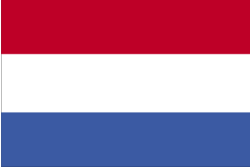Netherlands: Difference between revisions
imported>Michel van der Hoek No edit summary |
imported>Michel van der Hoek (I deleted the reference to the "Ural Mountains" as that seems completely out of place...) |
||
| Line 1: | Line 1: | ||
{{subpages}} | {{subpages}} | ||
[[Image:Flag of the Netherlands.gif|thumb|right|250px|The [[flag]] of the Netherlands.{{PD-image|Central Intelligence Agency}}]] | [[Image:Flag of the Netherlands.gif|thumb|right|250px|The [[flag]] of the Netherlands.{{PD-image|Central Intelligence Agency}}]] | ||
The '''Netherlands''' is a [[country]] that lies at the western end of the [[North European Plain | The '''Netherlands''' is a [[country]] that lies at the western end of the [[North European Plain]]. Except for the southeastern part, the Netherlands is flat and about 40% of the country lies below sea level. The inhabitants of the Netherlands, called the [[Dutch people|Dutch]], have built [[dikes]] to hold back the sea. The country is situated at the estuary of the river [[Rhine]], which originates in [[Switzerland]], and the river [[Meuse]], which runs via [[Belgium]] from [[France]] to the city of [[Rotterdam]], the main seaport of the Netherlands. | ||
The Netherlands is highly industrialized and one of the most densely populated countries in [[Europe]]. Its surface area is 41.528 km² (of which 18,41% is water) and its 2007 population is 16,570,613. This gives 489 inhabitants per km² of dry land. The capital of the country is [[Amsterdam]], while the government is seated in [[The Hague]]. | The Netherlands is highly industrialized and one of the most densely populated countries in [[Europe]]. Its surface area is 41.528 km² (of which 18,41% is water) and its 2007 population is 16,570,613. This gives 489 inhabitants per km² of dry land. The capital of the country is [[Amsterdam]], while the government is seated in [[The Hague]]. | ||
| Line 38: | Line 38: | ||
See also | See also | ||
*[[Dutch constitution]] | *[[Dutch constitution]] | ||
*P.J.A.N. Rietbergen. ''A Short History of the Netherlands. From Prehistory to the Present Day''. 5th ed. Amersfoort: Bekking, 2002. ISBN 9061094402 | |||
Revision as of 21:04, 28 April 2008
The Netherlands is a country that lies at the western end of the North European Plain. Except for the southeastern part, the Netherlands is flat and about 40% of the country lies below sea level. The inhabitants of the Netherlands, called the Dutch, have built dikes to hold back the sea. The country is situated at the estuary of the river Rhine, which originates in Switzerland, and the river Meuse, which runs via Belgium from France to the city of Rotterdam, the main seaport of the Netherlands.
The Netherlands is highly industrialized and one of the most densely populated countries in Europe. Its surface area is 41.528 km² (of which 18,41% is water) and its 2007 population is 16,570,613. This gives 489 inhabitants per km² of dry land. The capital of the country is Amsterdam, while the government is seated in The Hague.
The Netherlands was an independent republic from 1579 until 1806, when Napoleon Bonaparte appointed his brother Louis Bonaparte as the first king of the Netherlands. In 1810 the country ceased to exist, as it became part of the French Empire. After the Congress of Vienna in 1815, the country became a kingdom with William of Orange I as the first king. His descendant, Beatrix of Orange, is now queen of the Netherlands.
Government and Administration
National Government
The Netherlands are a constitutional monarchy with a bicameral parliament. The head of state is the monarch, currently Queen Beatrix. Under the Dutch Constitution, the monarch has to approve all legislation, appoints and dismisses government secretaries, and is head of the supreme court of appeal, but in practice, the monarch's power is limited and his role is largely ceremonial. The power of the executive is vested in the Cabinet (Dutch ministerraad "Council of Ministers"), headed by the Prime Minister, currently Jan Peter Balkenende.
Legislative power is held by the bicameral Dutch parliament. The Lower House (Dutch Tweede Kamer) has 150 seats, the members of which are elected by direct proportional elections. Members have the right to propose, sponsor, and amend bills. The term of office is four years. The Upper House (Dutch Eerste Kamer or Senaat) has 75 seats. The members of the Upper House are elected indirectly by the delegates of the provincial assemblies. Members only have the right to approve or reject legislation.
Administrative Divisions
The Netherlands is divided in provinces, twelve in total:
- Drenthe - capital: Assen
- Flevoland - capital: Lelystad
- Friesland (Frisian: Fryslân) - capital: Leeuwarden
- Gelderland - capital: Arnhem
- Groningen - capital: Groningen
- Limburg - capital: Maastricht
- Noord-Brabant - capital: 's-Hertogenbosch (also called Den Bosch)
- Noord-Holland - capital: Haarlem
- Overijssel - capital: Zwolle
- Utrecht - capital: Utrecht
- Zeeland - capital: Middelburg
- Zuid-Holland - capital: Den Haag (also: 's-Gravenhage; English: The Hague)
International Relations
The Netherlands are a founding member of the European Economic Community, which evolved into the present European Union. The country is also a member of NATO.
References
See also
- P.J.A.N. Rietbergen. A Short History of the Netherlands. From Prehistory to the Present Day. 5th ed. Amersfoort: Bekking, 2002. ISBN 9061094402
